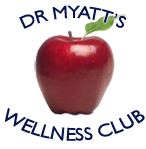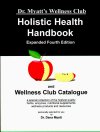Digest-Tone Tonic
Dr. Myatt's New Formula for Digestion
Lack of a normal amount of stomach acid is the main culprit in GERD
and many digestive disorders. If you mistakenly believe that GERD and heartburn
are due to too much stomach acid, please read this article: What's Burning You.
Stomach acid production tends to decrease with age. Stomach acid production is
necessary for normal diestion and assimilation of most nutrients. Digestive enzymes,
which replace "phase II" digestive enzymes, do NOT perform the same function as
normal stomach acid, which is "Phase I" of digestion.
Replacement with HCL (hydrochloric acid) is one way to reverse the decline of stomach acid.
However, many people find that using HCL is challenging because the dose must be closely
matched to the amount of protein and fats eaten with the meal.
Digest-Tone is an herbal tonic formulated by Dr. Myatt. It is a combination of herbs that helps to
naturally and safely increase and improve Phase I digestion in the stomach. In addition, Digest-Tone
acts in a variety of ways to improve stomach and digestive function:
- Stimulates digestive juices. "Bitter" herbs stimulate the stomach, liver, gallbladder and pancreas to begin secreting their digestive juices. (12, 19-20)
- Relieves gas. "Carminative" herbs help relieve both upper and lower GI gas and the discomfort that gas can cause. (2)
- Normalizes gastric motility, helping slow a "too-fast" gut and speeding up a sluggish gut.(6,10,13-14)
- Decreases cramping and spasm. (2,9,16,19)
- Relieves heartburn, indigestion and esophageal pressure. (19,20)
- Helps heal stomach ulcers and inflammation. (1,3-5,11,18,22)
- Stimulates production of the stomach's natural protective mucous. (11)
- Help eliminate gut-unfriendly bacteria and parasites including H. pylorii and Campylobacter.(7, 15,17,19,21)
Ingredients: Corydalis, Fennel, Ginger, Goldenseal, Hops, Licorice, Oregon Grape, Marshmallow Root.
Suggested dose: 1/2 to 1 teaspoon, 1 to 3 times per day, taken in 2 ounces of water or red wine, 15-30 minutes before a meal. Sip slowly for best effect.
Currently unavailable - inquire for availability
References
1.) Akazawa H, Kohno H, Tokuda H, Suzuki N, Yasukawa K, Kimura Y, Manosroi A, Manosroi J, Akihisa T. Anti-Inflammatory and Anti-Tumor-Promoting Effects of 5-Deprenyllupulonol C and Other Compounds from Hop (Humulus lupulus L.). Chem Biodivers. 2012 Jun;9(6):1045-54. doi: 10.1002/cbdv.201100233. [##hops; anti-inflammatory##]
2.) Alexandrovich I, Rakovitskaya O, Kolmo E, et al. The effect of fennel (Foeniculum Vulgare) seed oil emulsion in infantile colic: a randomized, placebo-controlled study. Altern Ther Health Med 2003;9:5861. {##fennel; colic##]
3.) Aly AM, Al-Alousi L, Salem HA. Licorice: a possible anti-inflammatory and anti-ulcer drug. AAPS PharmSciTech. 2005 Sep 20;6(1):E74-82. [##licorice; anti-inflammatory, anti-ulcer##]
4.) Blumenthal M, Busse WR, Goldberg A, et al, eds. The Complete German Commission E Monographs: Therapeutic Guide to Herbal Medicines. Austin: American Botanical Council and Boston: Integrative Medicine Communications, 1998, 167. [##marshmallow; anti-inflammatory##][
5.) Chang HM, But PPH. Pharmacology and Applications of Chinese Materia Medica vol 1. Singapore: World Scientific Inc., 1986, 521. {##corydalis; stomach ulcers##]
6.) Chen G, Zhu L, Liu Y, Zhou Q, Chen H, Yang J. Isoliquiritigenin, a flavonoid from licorice, plays a dual role in regulating gastrointestinal motility in vitro and in vivo. Phytother Res. 2009 Apr;23(4):498-506. [##licorice; gastric motility##]
7.) Cwikla C, Schmidt K, Matthias A, Bone KM, Lehmann R, Tiralongo E. Investigations into the antibacterial activities of phytotherapeutics against Helicobacter pylori and Campylobacter jejuni. Phytother Res. 2010 May;24(5):649-56. [##ginger, fennel, goldenseal: H. pylorii & Campylobacter##]
8.) Ghanem MT, Radwan HM, Mahdy el-SM, Elkholy YM, Hassanein HD, Shahat AA. Phenolic compounds from Foeniculum vulgare (Subsp. Piperitum) (Apiaceae) herb and evaluation of hepatoprotective antioxidant activity. Pharmacognosy Res. 2012 Apr;4(2):104-8. [##fennel; antioxidant##]
9.) Ghayur MN, Gilani AH. Pharmacological basis for the medicinal use of ginger in gastrointestinal disorders. Dig Dis Sci. 2005 Oct;50(10):1889-97. [##ginger; anti-spasmodic##]
10.) Hu ML, Rayner CK, Wu KL, Chuah SK, Tai WC, Chou YP, Chiu YC, Chiu KW, Hu TH. Effect of ginger on gastric motility and symptoms of functional dyspepsia. World J Gastroenterol. 2011 Jan 7;17(1):105-10. [##ginger; gastric empyting##]
11.) Khayyal MT, el-Ghazaly MA, Kenawy SA, Seif-el-Nasr M, Mahran LG, Kafafi YA, Okpanyi SN.Antiulcerogenic effect of some gastrointestinally acting plant extracts and their combination. Arzneimittelforschung. 2001;51(7):545-53. [##licorice; anti-ulcer, increased mucous##]
12.) Kurasawa T, Chikaraishi Y, Naito A, Toyoda Y, Notsu Y. Effect of humulus lupulus on gastric secretion in a rat pylorus-ligated model. Biol Pharm Bull. 2005 Feb;28(2):353-7. [##hops; increased gastric juice##]
13.) Lee TH, Kim KH, Lee SO, Lee KR, Son M, Jin M. Tetrahydroberberine, an isoquinoline alkaloid isolated from corydalis tuber, enhances gastrointestinal motor function. J Pharmacol Exp Ther. 2011 Sep;338(3):917-24. Epub 2011 Jun 9. {##corydalis improves gastric motility##]
14.) Lee TH, Son M, Kim SY. Effects of corydaline from Corydalis tuber on gastric motor function in an animal model. Biol Pharm Bull. 2010;33(6):958-62. [##corydalis improves gastric motility##]
15.) Li Y, Xu C, Zhang Q, Liu JY, Tan RX. In vitro anti-Helicobacter pylori action of 30 Chinese herbal medicines used to treat ulcer diseases. J Ethnopharmacol. 2005 Apr 26;98(3):329-33. [##corydalis, H. pylorii##]
16.) Perez ME, Youssef NN. Dyspepsia in childhood and adolescence: insights and treatment considerations. Curr Gastroenterol Rep. 2007 Dec;9(6):447-55. [##ginger; abdominal pain##]
17.) Scazzocchio F, Cometa MF, Tomassini L, Palmery M. Antibacterial activity of Hydrastis canadensis extract and its major isolated alkaloids. Planta Med. 2001 Aug;67(6):561-4. [##goldenseal; anti-microbial##]
18.) Sumbul S, Ahmad MA, Mohd A, Mohd A. Role of phenolic compounds in peptic ulcer: An overview. J Pharm Bioallied Sci. 2011 Jul;3(3):361-7. [##fennel, ginger; anti-ulcer##]
19.) Tewari JP, Srivastava MC, Bajpai JL. Pharmacologic studies of Achillea millefolium Linn. Indian J Med Sci 1994;28(8):3316. [##oregon grape; bitter, anti-spasmodic, anti-microbial##]
20.) Valussi M. Functional foods with digestion-enhancing properties. Int J Food Sci Nutr. 2012 Mar;63 Suppl 1:82-9. Epub 2011 Oct 19. [##fennel; digestion##]
21.) Wittschier N, Faller G, Hensel A. Aqueous extracts and polysaccharides from liquorice roots (Glycyrrhiza glabra L.) inhibit adhesion of Helicobacter pylori to human gastric mucosa. J Ethnopharmacol. 2009 Sep 7;125(2):218-23. Epub 2009 Jul 14. [##licorice; anti-infective##]
22.) Zaidi SF, Muhammad JS, Shahryar S, Usmanghani K, Gilani AH, Jafri W, Sugiyama T. Anti-inflammatory and cytoprotective effects of selected Pakistani medicinal plants in Helicobacter pylori-infected gastric epithelial cells. J Ethnopharmacol. 2012 May 7;141(1):403-10. Epub 2012 Mar 13. [##fennel; anti-inflammatory##]







